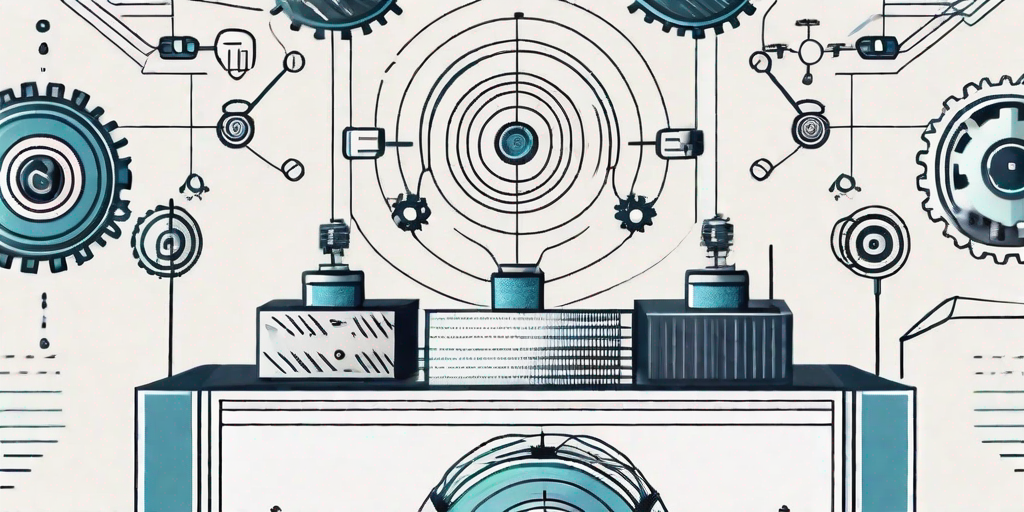Strategy Keynote Speaker: Enhancing Your Understanding of Drones

Strategy Keynote Speaker: Enhancing Your Understanding of Drones
Unmanned aerial vehicles, or drones, have become an increasingly common sight in our skies. Whether used for recreational purposes, commercial applications, or even in the military, these flying machines have transformed various industries and opened up new possibilities. However, understanding the intricacies and complexities of drone technology can be a daunting task. This is where a strategy keynote speaker can play a crucial role in enhancing your understanding of drones.
Understanding the Basics of Drone Technology
Before delving into the applications and potential of drones, it is important to grasp the fundamentals of their technology. Drones are essentially unmanned aircraft that can be remotely controlled or operate autonomously. They are equipped with sensors, cameras, and other sophisticated technology that allow them to gather data, capture images and videos, and perform a wide range of tasks.
To fully comprehend drone technology, one must familiarize oneself with concepts such as flight dynamics, aerodynamics, navigation systems, and propulsion. By understanding the principles that govern the operation of drones, one can better appreciate their capabilities and limitations.
Flight dynamics is a crucial aspect of drone technology. It involves the study of how drones move through the air and maintain stability. Drones utilize various control systems, including gyroscopes, accelerometers, and flight controllers, to ensure smooth and controlled flight. These systems constantly monitor the drone's position, altitude, and orientation, making adjustments as needed to maintain stability and maneuverability.
Aerodynamics plays a significant role in the design and performance of drones. The shape and structure of the drone's body, wings, and propellers are carefully engineered to optimize lift, reduce drag, and enhance overall efficiency. Understanding the principles of aerodynamics helps drone designers create sleek and streamlined aircraft that can achieve longer flight times and higher speeds.
Navigation systems are essential for drones to navigate their surroundings accurately. Global Positioning System (GPS) technology is commonly used to provide precise location information, allowing drones to follow pre-programmed flight paths or autonomously navigate to specific coordinates. In addition to GPS, drones may also utilize other navigation aids such as inertial measurement units (IMUs) and altimeters to maintain accurate positioning and altitude.
Propulsion is another critical aspect of drone technology. Drones use various propulsion methods, including electric motors, internal combustion engines, and even jet engines, depending on their size and purpose. Electric motors are commonly used in smaller drones due to their lightweight and efficient nature, while larger drones may rely on more powerful engines for increased payload capacity and longer flight durations.
By understanding the basics of drone technology, one can begin to appreciate the vast potential and applications of these unmanned aircraft. From aerial photography and videography to search and rescue operations, drones have revolutionized various industries and continue to push the boundaries of what is possible. As technology advances, drones are becoming increasingly sophisticated, with improved flight capabilities, longer battery life, and enhanced sensors, opening up new opportunities for exploration and innovation.
How a Strategy Keynote Speaker Can Teach You the Applications of Drones
As the use of drones continues to grow, businesses and industries are discovering innovative ways to leverage this technology. A strategy keynote speaker can provide valuable insights into the various applications of drones across different sectors.
For example, in the agriculture industry, drones are revolutionizing crop monitoring, irrigation management, and pesticide application. By using aerial imagery and advanced sensors, farmers can gather accurate data about their fields, target problem areas, and optimize their farming practices.
In addition, drones equipped with thermal cameras can detect variations in crop temperature, helping farmers identify areas of stress or disease. This early detection allows for timely intervention, preventing potential crop losses and increasing overall yield. Furthermore, drones can also be used to distribute beneficial insects or release biological control agents, reducing the need for chemical pesticides and promoting sustainable farming practices.
In the construction industry, drones are being employed for surveying, mapping, and inspections. The ability to capture high-resolution images and create detailed 3D models allows construction companies to streamline their processes, improve safety, and reduce costs.
Moreover, drones equipped with LiDAR (Light Detection and Ranging) technology can quickly and accurately measure distances and create precise elevation models. This information is crucial for planning and designing infrastructure projects, such as roads, bridges, and buildings. By using drones, construction companies can save time and resources, as well as minimize the risks associated with manual surveying.
By showcasing real-world examples and case studies, a strategy keynote speaker can demonstrate how drones are reshaping industries and inspiring creative solutions to complex problems.
For instance, in the energy sector, drones are being used for inspecting power lines, wind turbines, and solar panels. Traditional methods of inspection often involve sending workers to dangerous heights or using expensive equipment, leading to increased costs and safety risks. However, drones equipped with high-resolution cameras and thermal imaging sensors can perform these inspections more efficiently and safely. They can identify potential issues, such as damaged components or faulty connections, allowing for timely maintenance and preventing costly downtime.
Furthermore, drones are also being utilized in search and rescue operations. In emergency situations, time is of the essence, and drones can provide a rapid aerial view of the affected area, helping rescuers locate missing persons or assess the extent of damage. Equipped with thermal cameras and advanced imaging technology, drones can detect heat signatures and identify survivors even in challenging environments, such as dense forests or collapsed buildings.
Additionally, drones are making a significant impact in the field of wildlife conservation. They are being used to monitor and protect endangered species, track animal populations, and combat illegal poaching. With their ability to cover large areas quickly and quietly, drones can gather valuable data about wildlife habitats, migration patterns, and behavior. This information is crucial for effective conservation efforts and can help authorities identify and apprehend poachers.
In conclusion, the applications of drones are vast and diverse, with industries across the board finding innovative ways to utilize this technology. A strategy keynote speaker can provide valuable insights into these applications, showcasing real-world examples and inspiring creative solutions. From agriculture to construction, energy to wildlife conservation, drones are reshaping industries and revolutionizing the way we approach complex problems.
The Role of Drones in Various Industries
Drones are not limited to specific industries; they have found applications in a multitude of sectors. In the field of filmmaking, for instance, drones are used to capture breathtaking aerial footage that adds a whole new dimension to storytelling. The ability to maneuver and film from unique angles allows filmmakers to create visually stunning sequences that were once only possible with expensive equipment and helicopters.
In addition to filmmaking, drones have also made a significant impact in the delivery and logistics sector. Companies like Amazon are exploring the use of drones to revolutionize the way goods are transported. With their ability to navigate through congested areas and deliver packages within a short timeframe, drones offer a promising solution to the challenges faced by traditional delivery methods.
But the applications of drones go beyond just entertainment and delivery. They are also playing a crucial role in search and rescue operations. Equipped with thermal imaging cameras and high-resolution sensors, drones can quickly locate missing persons or survivors in disaster-stricken areas. Their ability to cover large areas in a short amount of time makes them invaluable tools in time-sensitive situations.
Furthermore, drones are being used for environmental monitoring and conservation efforts. With their aerial capabilities, they can survey vast areas of land and collect data on wildlife populations, habitat conditions, and environmental changes. This information is vital for researchers and conservationists to make informed decisions and take necessary actions to protect our planet.
Speaking of environmental protection, drones are also being employed to combat illegal activities such as poaching and deforestation. Equipped with advanced cameras and sensors, these drones can monitor remote areas and detect any suspicious activities. This helps authorities in their efforts to preserve endangered species and prevent further damage to our forests.
Moreover, drones have found applications in the agriculture industry. Farmers are using drones to monitor crop health, identify areas of pest infestation, and optimize irrigation. By collecting data on plant health and growth patterns, drones enable farmers to make informed decisions and take proactive measures to increase crop yields and reduce the use of pesticides.
Lastly, drones are being utilized in the construction industry for surveying and mapping purposes. With their ability to capture high-resolution images and create detailed 3D models, drones are streamlining the surveying process and reducing costs. They can quickly and accurately assess the topography of a construction site, identify potential hazards, and aid in the planning and design stages of a project.
In conclusion, drones have become indispensable tools in various industries. From filmmaking to delivery, search and rescue to environmental monitoring, and agriculture to construction, drones are revolutionizing the way we work and interact with our surroundings. With advancements in technology and regulations, we can expect drones to continue pushing boundaries and finding new applications in the future.
Strategy Keynote Speaker on Implementing Drone Strategies in Business
While understanding the various applications of drones is important, businesses also need to consider how to integrate this technology effectively into their operations. This is where a strategy keynote speaker can provide invaluable guidance.
Developing a drone strategy involves evaluating the potential benefits and risks, understanding regulatory frameworks, selecting the right equipment, and training personnel. A strategy keynote speaker can help businesses navigate these complexities by sharing best practices, discussing regulatory considerations, and highlighting successful implementation strategies from industry leaders.
Moreover, a strategy keynote speaker can emphasize the importance of aligning drone strategies with overall business objectives. By demonstrating how drones can enhance productivity, efficiency, and profitability, companies can make informed decisions about incorporating this technology into their business models.
The Future of Drones as Explained by Experts
As with any emerging technology, the future of drones holds immense potential for innovation and advancement. Experts in the field can provide valuable insights into the trends and developments that are shaping the future of drones.
For instance, advancements in battery technology and the integration of artificial intelligence are expected to significantly enhance the capabilities of drones. Longer flight times, increased payload capacities, and autonomous decision-making are just some of the advancements that will propel the use of drones to new heights.
Additionally, experts can shed light on the regulatory challenges and ethical considerations surrounding drone technology. Striking a balance between privacy concerns, airspace regulations, and the numerous advantages that drones offer will be a key area of focus as the field continues to evolve.
Conclusion
Without a doubt, drones are transforming industries and unlocking new possibilities. Whether you are an executive looking to understand the potential of drones for your business or an enthusiast seeking to deepen your knowledge, a strategy keynote speaker can be your guide in enhancing your understanding of drones. By demystifying the technology, exploring its applications, and providing insights into effective implementation strategies, a strategy keynote speaker can empower you to embrace the potential of drones and navigate the ever-evolving landscape of this exciting technology.
FAQ
1. What are the basics of drone technology?
Drones are unmanned aircraft that can be controlled remotely or operate autonomously. They are equipped with sensors, cameras, and advanced technology to gather data, capture images and videos, and perform various tasks. Understanding flight dynamics, aerodynamics, navigation systems, and propulsion is essential to grasp the fundamentals of drone technology.
2. What are the applications of drones in different industries?
Drones have revolutionized industries such as agriculture, construction, energy, wildlife conservation, filmmaking, delivery, search and rescue, and environmental monitoring. They are used for crop monitoring, surveying, inspections, power line inspections, wildlife monitoring, and more. Drones offer innovative solutions to complex problems and improve efficiency and safety in various sectors.
3. How can a strategy keynote speaker help businesses implement drone strategies?
A strategy keynote speaker can provide guidance on developing drone strategies by evaluating benefits and risks, understanding regulations, selecting equipment, and training personnel. They can also emphasize aligning drone strategies with overall business objectives, showcasing how drones can enhance productivity, efficiency, and profitability. A strategy keynote speaker can help businesses navigate complexities and make informed decisions about incorporating drones into their operations.
Contact a Strategy Keynote Speaker for your event
Interested in diving deeper into the exciting world of drones? Dr Mark van Rijmenam, a renowned strategy keynote speaker, can provide invaluable insights and guidance tailored to your needs. From understanding the fundamentals of drone technology to exploring its vast applications across various industries, Dr van Rijmenam will empower you with the knowledge to leverage this transformative technology. His expertise will enable you to navigate the complexities of integrating drones into your operations, aligning them with your business objectives, and staying ahead of regulatory and ethical considerations. Don't miss this opportunity to enhance your understanding of drones and their potential for your business. Simply complete the form below, and we will be in touch within 24 hours to discuss how Dr van Rijmenam can add value to your next event.
Thanks for your inquiry
We have sent you a copy of your request and we will be in touch within 24 hours on business days.
If you do not receive an email from us by then, please check your spam mailbox and whitelist email addresses from @thedigitalspeaker.com.
In the meantime, feel free to learn more about The Digital Speaker here.
Or read The Digital Speaker's latest articles here.






